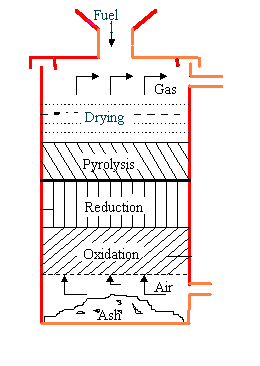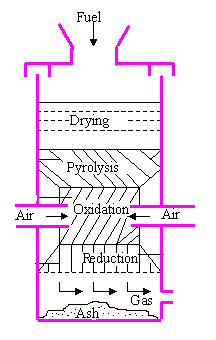Updraft gas producer

An updraft gasifier has clearly defined zones for partial combustion, reduction, and pyrolysis. Air is introduced at the bottom and act as countercurrent to fuel flow. The gas is drawn at higher location. The updraft gasifier achieves the highest efficiecy as the hot gas passes through fuel bed and leaves the gasifier at low temperature. The sensible heat given by gas is used to preheat and dry fuel. Disadvantages of updraft gas proucer are excessive amount of tar in raw gas and poor loading capability. Hence it is not suitable for running vehicle.
Downdraft gas producer

In the updraft gasifier, gas leaves the gasifier with high tar vapour which may seriously interfer the operation of internal combustion engine. This problem is minimized in downdraft gasifier. In this type, air is introduced into downward flowing packed bed or solid fuels and gas is drawn off at the bottom. A lower overall efficiency and difficulties in handling higher moisture and ash content are common problems in small downdraft gas producers. The time (20-30 minutes) needed to ignite and bring plant to working temperature with good gas quality is shorter than updraft gas producer. This gasifier is preferred to updraft gasifier for internal combustion engines
Twin-fire gas producer

The advantage of co-current and counter-current gasifiers are combined in a so a called twin-fire gasifier. It consists of two defined reaction zones. Drying, low-temperature carbonisation, and cracking of gases occur in the upper zone, while permanent gasification of charcoal takes in lower zone. The gas temperature lies between 460 to 520 o C. Total process takes place with under pressure of -30 mbar. Twin-fire gasifier produces fairly clean gas.
Crossdraft gas producer

Crossdraft gas producers, although they have certain advantages over updraft and downdraft gasifiers, they are not of ideal type. The disadvantages such as high exit gas temperature, poor CO 2 reduction and high gas velocity are the consequence of the design. Unlike downdraft and updraft gasifiers, the ash bin, fire and reduction zone in crossdraft gasifiers are separated. This design characteristics limit the type of fuel for operation to low ash fuels such as wood, charcoal and coke. The load following ability of crossdraft gasifier is quite good due to concentrated partial zones which operates at temperatures up to 2000 o c. Start up time (5-10 minutes) is much faster than that of downdraft and updraft units. The relatively higher temperature in cross draft gas producer has an obvious effect on gas composition such as high carbon monoxide, and low hydrogen and methane content when dry fuel such as charcoal is used. Crossdraft gasifier operates well on dry air blast and dry fuel.
Other gas producer
Although updraft, downdraft or crossdraft gas producers have been the most commonly built types, there is a wide variety of gasifiers which do not really fit into any of these categories and are classified as other gas producers . Some units are built to combine the advantages of crossdraft with downdraft or updraft gas producers.To retun to main page click here
This page is developed and maintened by :
Chandrakant Turare ,
ARTES Institute,
University of Flensburg
Flensburg, Germany
Email: chand@uni-flensburg.de